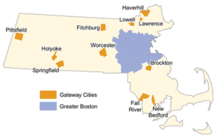Massachusetts gateway cities

Massachusetts gateway cities are "midsize urban centers that anchor regional economies around the state," facing "stubborn social and economic challenges" while retaining "many assets with unrealized potential." These communities, which all had a legacy of economic success, have struggled as the state's economy shifted toward skills-centered knowledge sectors (increasingly clustered in and around Boston).
Original cities and the Compact
The designation initially comprised eleven cities named in a 2007 report co-authored by the Brookings Institution and the Massachusetts Institute for a New Commonwealth (MassINC). In May 2008 the chief executives of the eleven Gateway Cities gathered at the Old State House in Boston "to sign a compact to unite their administrations in future efforts aimed at economic and community development," asserting their desire to work cooperatively to address issues of common concern.[1]
- Brockton
- Fall River
- Fitchburg
- Haverhill
- Holyoke
- Lawrence
- Lowell
- New Bedford
- Pittsfield
- Springfield
- Worcester
Additional cities
A legislative definition (Section 3A of Chapter 23A of the General Laws of Massachusetts) put in place in 2009 and amended in 2010 expanded the designation of gateway cities with thirteen more locations, for a total of 24 cities. Under the General Laws, gateway cities have a population between 35,000 and 250,000, with an average household income below the state average and an average educational attainment rate (Bachelor's or above) below the state average. Updates to the Census data in 2013 led to the addition of two cities (Attleboro and Peabody) for a total of 26 communities.
- Attleboro
- Barnstable
- Chelsea
- Chicopee
- Everett
- Leominster
- Lynn
- Malden
- Methuen
- Peabody
- Quincy
- Revere
- Salem
- Taunton
- Westfield
Impact
- The Gateway Cities Legislative Caucus was founded in 2008 by State Representative Antonio F.D. Cabral and State Senator Stephen J. Buoniconti. As House and Senate co-chairs of the Caucus, they were joined by 58 other representatives and 20 other senators who represent Gateway Cities. In 2012, Senator Benjamin Downing replaced retiring Senator Buoniconti as the Senate chair.
- The Urban Initiative at the University of Massachusetts Dartmouth was launched by Chancellor Jean MacCormack in direct response to the Gateway Cities report.
- In October 2012, MassINC launched the Gateway Cities Innovation Institute.